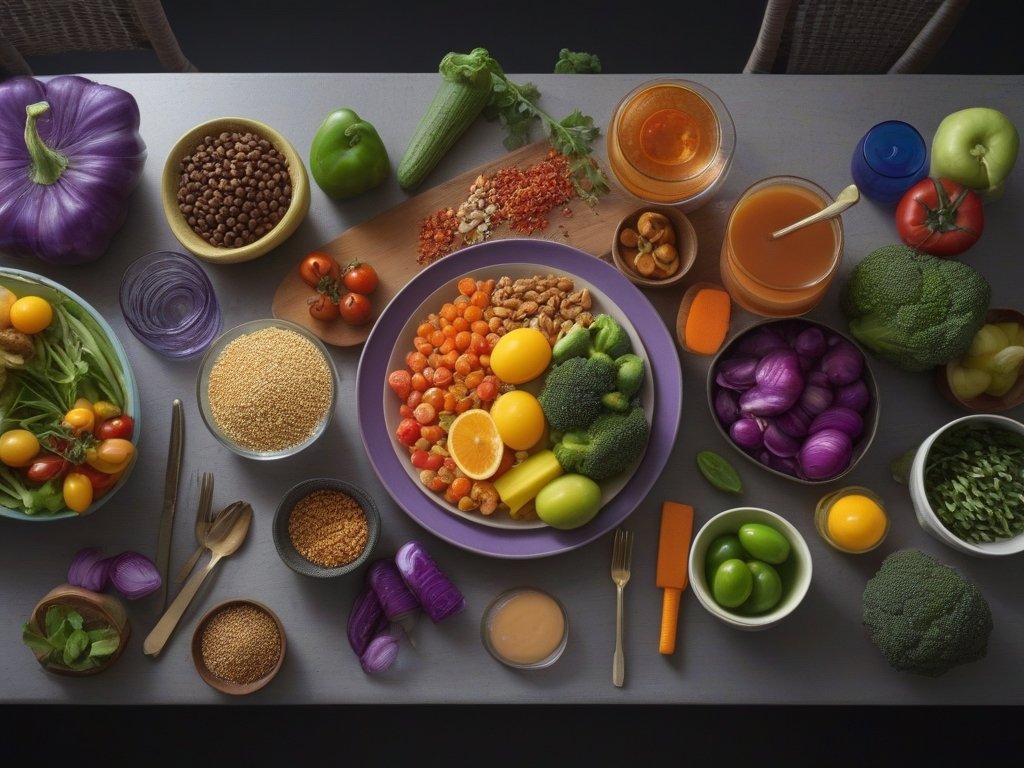Healthy Fall Meals – 2024
DATE : 11 October 2024 By : Tareq Qteshat

Healthy Fall Meals – Nourishing Fall Meals for Immune Support
Incorporating seasonal produce and nutrient-dense foods into fall meals plays a vital role in maintaining overall well-being.
Leafy greens, cruciferous vegetables, and root vegetables provide essential nutrients. Adding these to meals supports immune function and reduces inflammation.
Warm and Nourishing Meal Options
Soups like butternut squash or lentil soup offer a nutrient-rich meal option.
Seasonal stews and braises with lean protein sources and herbs such as turmeric and ginger can also be a healthy choice. These meals not only warm the body but also provide essential nutrients.
Healthy Breakfast Options
Oatmeal, Greek yogurt, or whole grain waffles with seasonal fruits and nuts make for a nutritious breakfast.
Experimenting with different combinations can help find the perfect meal to start the day. These nutrient-dense foods provide sustained energy and support immune function.
Customizing Fall Meals
Investigating various meal options can help find the perfect combination for individual needs.
With a focus on seasonal produce and nutrient-dense foods, it’s possible to create a balanced and nourishing meal plan.
Key Takeaways
Fall Produce for Optimal Health
Incorporating seasonal produce into your diet can have a significant impact on your overall health. Fruits and vegetables available during the fall season offer numerous benefits, including supporting healthy digestion and reducing inflammation.
Nutritious Soups for a Healthy Fall
Soups made with seasonal ingredients like butternut squash and lentils are rich in vitamins and fiber, making them an excellent option for a healthy fall meal. These soups can be made with lean protein sources and locally sourced produce, adding essential nutrients and amino acids to your diet.
Hearty Salads for a Boost of Energy
Fall salads featuring seasonal fruits and vegetables provide essential nutrients like fiber, vitamin C, and beta-carotene. These nutrients are vital for maintaining optimal health and can help support your immune system during the fall season.
Breakfast Options for Sustained Energy
Starting your day with a nutrient-dense breakfast can help provide sustained energy throughout the morning. Oatmeal and Greek yogurt are excellent options, offering a rich source of fiber and protein to support overall health.
“As we navigate the changing seasons, it’s essential to adapt our diets to incorporate seasonal produce, ensuring we’re fueling our bodies with the nutrients they need to thrive.”
Fall Produce to Incorporate
Fall Produce: Unlock the Power of Seasonal Fruits and Vegetables
As you walk through the lively fall markets, you’ll find a wide variety of fruits and vegetables that are rich in nutrients, fiber, and antioxidants. These seasonal produce can help you reap numerous health benefits when incorporated into your meals.
For instance, leafy greens like kale, spinach, and collard greens are packed with vitamins A, C, and K. You can easily grow them at home using space-saving gardening techniques to ensure a constant supply. Simply sauté them with garlic for a delicious side dish.
Incorporating cruciferous vegetables like broccoli, cauliflower, and Brussels sprouts into your meals can also have numerous benefits. These vegetables contain sulforaphane, which has anti-inflammatory properties. Roasting them with olive oil and herbs can make for a tasty side dish.
Eating these fall produce can help support healthy digestion, reduce inflammation, and even enhance your immune system.
Growing your own leafy greens can also have a positive impact on the environment. It reduces the need for transporting vegetables over long distances, which can help minimize your carbon footprint.
Making informed food choices can help you maintain a well-rounded diet. Focus on whole, seasonal foods to nourish your body and reduce your reliance on processed foods.
Custom Quote: “Eating with the seasons allows us to reconnect with nature and appreciate the simple joys of fresh, wholesome food.”
Warm and Nourishing Soups
Warm and Nourishing Soups for a Healthy Fall Season
Incorporating warm and nourishing soups into your fall meals can be a great way to provide your body with essential nutrients and energy.
These soups, made with seasonal produce, offer numerous health benefits and can be especially helpful for individuals who’ve a harder time getting the nutrients they need. For those who may be hesitant to eat a variety of vegetables, soups can be a more palatable option.
Soups like butternut squash, rich in vitamin A and fiber, can be a delicious and healthy choice. Lentil soup with carrots and celery is another option, high in protein and fiber. Spicy pumpkin soup with kale is also packed with vitamins A and K.
When making these soups, it’s essential to be mindful of the ingredients used. Low-sodium broth and limited amounts of cream or sugar are recommended. Experimenting with different spices and herbs can also add flavor without extra calories.
Incorporating these soups into your meal routine can provide a healthy and delicious fall season.
For example, a warm bowl of soup can help to energize your immune system and combat seasonal colds. As the weather cools down, a nutritious soup can be a great way to provide your body with the energy it needs to stay healthy.
Seasonal Stews and Braises
Seasonal Stews and Braises: A Nutritious and Delicious Way to Eat
Using seasonal ingredients is a great way to add nutrients to your meals during the fall season. Locally sourced produce such as root vegetables, leafy greens, and squash are rich in vitamins, minerals, and antioxidants, and are also high in fiber.
This can help promote digestive health and support healthy blood sugar levels. Incorporating space-saving gardening techniques can allow you to grow your own leafy greens and other ingredients in small spaces.
Varieties like kale and chard can thrive in compact containers, making it easy to enjoy the benefits of homegrown produce even in a limited space.
When preparing stews and braises, choose lean protein sources like chicken, turkey, or plant-based options like beans and lentils. These protein sources provide essential amino acids and can help support muscle growth and maintenance.
Herbs and spices like turmeric and ginger have anti-inflammatory properties and can help support immune health.
To make your stews and braises healthier, use low-sodium broth and limit added salt and sugar. Experiment with different cooking methods like slow cooking or pressure cooking to help retain the nutrients in your ingredients.
This approach can help you create nutritious and delicious stews and braises that support your overall health and well-being.
Hearty Fall Salads
Embracing the Flavors of the Season: Hearty Fall Salads
Fall is the perfect time to experiment with seasonal produce and create delicious, nutritious salads. As the weather cools down, incorporate seasonal fruits and vegetables like apples, pears, and squash into your salads.
These ingredients add flavor and provide essential nutrients like fiber, vitamin C, and beta-carotene.
Incorporating new fruits and vegetables can be challenging for picky eaters, but learning to eat healthy can make a significant difference in their overall health. Understanding the importance of meal planning can also help picky eaters ensure they’re getting the nutrients they need.
To create a variety of hearty fall salads, combine different ingredients. Try these ideas:
- Roasted butternut squash with mixed greens, crumbled goat cheese, and a citrus vinaigrette
- Grilled chicken with chopped kale, dried cranberries, and a tangy apple cider dressing
- Sautéed spinach with sliced apples, crumbled blue cheese, and a balsamic vinaigrette
When creating your own hearty fall salads, aim to include a variety of colors and textures to ensure you’re getting a range of nutrients. Experimenting with different ingredients and dressings can help you find the combinations that work best for you.
By doing so, you’ll be able to enjoy the flavors of the season while nourishing your body.
“The key to a great salad is balance and variety. Experiment with different ingredients, and don’t be afraid to try new things.”
Nutritious Breakfast Options
Revamping Your Breakfast Routine for a Nutritious Start
As the seasons change, it’s time to reassess your breakfast routine. A well-planned morning meal can provide sustained energy and support overall health. Incorporating nutrient-dense foods into your breakfast can help you break free from the monotony of the same old meal.
| Nutritious Fall Breakfast Options | Key Nutrients |
|---|---|
| Oatmeal with Apple and Cinnamon | Fiber, vitamins A and C, and antioxidants |
| Greek Yogurt with Pumpkin and Walnuts | Protein, calcium, and omega-3 fatty acids |
| Whole Grain Waffles with Cranberries and Orange Zest | Complex carbohydrates, vitamins C and K, and minerals |
| Smoked Salmon with Avocado Toast | Omega-3 fatty acids, vitamins D and B12, and healthy fats |
| Smoothie Bowl with Sweet Potatoes and Almond Milk | Vitamins A and C, minerals, and complex carbohydrates |
A nutritious breakfast is crucial for maintaining energy levels and supporting overall health. Incorporating a variety of whole foods into your morning meal can provide the necessary nutrients for a healthy start. By making a few simple changes to your breakfast routine, you can reap the benefits of a balanced diet and set yourself up for a productive day.
Frequently Asked Questions
Can I Still Eat Fall Produce in the Winter Months?
Fall produce can be enjoyed during the winter months through preservation methods or by purchasing from local farmers who utilize cold storage or greenhouses. This allows you to enjoy seasonal flavors year-round.
How Do I Store Seasonal Ingredients for Extended Periods?
Preserving Seasonal Ingredients for Later Use
To make the most of seasonal ingredients, consider freezing or canning items like fruits and vegetables. This helps lock in nutrients and maintain quality. For best results, use airtight containers to store items, keeping them fresh for extended periods.
When freezing, it’s essential to follow proper techniques to preserve the nutritional value and texture of your ingredients. For example, blanching vegetables before freezing can help inactivate enzymes that cause spoilage.
For canning, choose a suitable method, such as water bath canning or pressure canning, depending on the type of food you’re preserving. Always follow tested recipes and guidelines to ensure your canned goods are safe to eat.
Airtight containers can be used for storing a variety of ingredients, including grains, nuts, and dried fruits. Look for containers made from high-quality materials, like glass or stainless steel, that are designed to keep air out and maintain freshness.
Are Fall Meals Suitable for People With Dietary Restrictions?
Fall meals can accommodate various dietary needs with some planning. Adaptations can be made to traditional recipes to make them gluten-free, vegan, or low-sodium. By substituting specific ingredients and adding creative elements, people with dietary restrictions can enjoy seasonal meals without feeling left out.
Can I Use Leftover Fall Ingredients for Future Meals?
Using leftover fall ingredients is a great way to reduce food waste and create new meals. Consider freezing or refrigerating items like roasted vegetables and cooked proteins. These can be incorporated into future meals, such as soups, stews, or salads. For example, leftover roasted butternut squash can be used in a warm winter soup, while cooked chicken can be added to a fresh green salad. By repurposing leftover ingredients, you can create a variety of meals while minimizing food waste.
How Do I Safely Cook and Reheat Fall Meals?
Safe Cooking Techniques for Fall Meals
When cooking fall meals, it’s crucial to prioritize food safety to prevent bacterial growth and preserve nutrients. One simple and effective way to ensure your meals are cooked safely is to use a food thermometer. This handy tool helps you achieve the perfect internal temperature of 165°F, which is essential for preventing bacterial blooms and maintaining nutritional value.
Using a food thermometer is especially important when cooking and reheating meals, as it guarantees that your food has reached a safe temperature. This is particularly crucial for dishes that contain meat, poultry, or dairy products, which can be breeding grounds for bacteria if not cooked properly.
Conclusion
Incorporating fall produce into your meals can significantly lower your risk of developing chronic diseases, such as heart disease and diabetes. A diet rich in fruits and vegetables plays a crucial role in maintaining overall health. Warm and nourishing soups, seasonal stews and braises, and hearty fall salads are delicious meal options that can be easily incorporated into your diet. Additionally, nutritious breakfast options can provide a great start to your day, setting you up for a healthier lifestyle.
The Centers for Disease Control and Prevention (CDC) emphasize the importance of a balanced diet in maintaining overall health. Fruits and vegetables are rich in essential nutrients, such as vitamins and minerals, that help support immune function and reduce inflammation. By making a few simple changes to your diet, you can take a proactive step towards a healthier you.
Fall produce offers a wide variety of options to incorporate into your meals. From apples and pumpkins to sweet potatoes and kale, there are many delicious and nutritious options to choose from. By trying new recipes and experimenting with different flavors, you can create a healthy and balanced diet that meets your nutritional needs.










